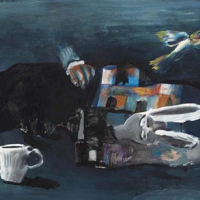CHARLES BLACKMAN, Untitled 1955-56

This intriguing precursor to the Alice in Wonderland series has recently emerged from a private collection where it has been slumbering almost since Blackman created it. It may have been painted in 1955 in the bush house on Tamborine Mountain that belonged to the poet Judith Wright (1915-2000) and her philosopher husband Jack McKinney (1891-1966). A more likely scenario perhaps is that it was painted at Avonsleigh, outside Melbourne, in the cottage the Blackmans rented across the bull paddock from Joy Hester (1920-1960) and Gray Smith where Charles used the bedroom as a studio. In either case, Blackman was engaged in a creative exchange with poets; he was breathing in the fresh country air, evolving his ideas, falling down rabbit holes and painting on large sheets of lithographic paper he transported from the coach house in Hawthorn.
The immediate fascination of this precursor to the series proper is that the work deals with the creative process itself. It contrasts the two different realities and links them to the realities of his own life. As Blackman said on the ABC, he was absolutely thrilled with Lewis Carroll’s story and it seemed ‘to sum up for me at that particular moment my feelings towards surrealism, and that anything could happen. The cup could lift off the table by itself… The world is a magical and very possible place for all one’s dreams and feelings.’1
Here, the black square in the lower centre appears to reference the talking book machine recently acquired by Barbara on which they listened to the story of Alice’s Adventures in Wonderland. At the same time the black square seems also to reference the Ned Kelly helmet - the device that Sidney Nolan (1917-1992) had used a decade earlier as a connecting link for his Ned Kelly series. This is a sign that the Blackmans are envisaging the creation of an equivalent series, a feminine counterpart to the Ned Kelly series and an expression of their own myth.
To the right of this black square box lies the shadowed face of a dozing/ listening Barbara who is the artist’s wife and muse. Her contemplative and transforming presence acts as a kind of warm pillow for the artist in his persona as the White Rabbit. Her increasing blindness contrasts with his alertness. The rabbit is wide awake, goggle-eyed with freshly painted ears that are quivering with anticipation.
Above him is a dream castle, a pastel-coloured and rather Klee-like vision of towers, turrets and doorways opening up in all directions - a childlike creation that looks suspiciously like the Blackmans’ patchwork quilt. This castle in the air releases (in the upper right) a phoenix-like bird in singing colours. Heading for the beyond, this soaring bird is an alter ego of the artist (and mate for Nolan’s Pretty Polly) and also a counterbalance to the equivalent image of magical intervention in the upper left: a gentle feminine cuff and touching hand, daubed with paint, that appears above the blackness of the dark hills in the middle ground, a signal perhaps that Alice is always there.
These poetic images that are conceived as paintings in the mind float within a strongly brushed blue ground, between dusk and dawn, a dreamy space that is anchored in the left foreground by a fully formed white teacup, standing on its own shadow, handle facing the artist. They presage the sensual, psychological, philosophical and poetical paintings that form the series proper.
Charles Blackman and Elwyn Lynn (1917-1997) enjoyed a mutual creative exchange in the mid-fifties.
Footnotes
1. Sunday Night Radio Two, ABC Radio, 9 September 1973
Felicity St John Moore